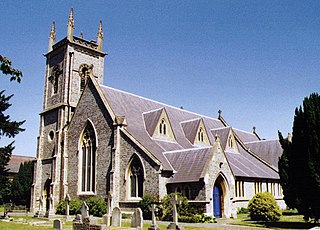
Earley is a town and civil parish in the Borough of Wokingham, Berkshire, England. Along with the neighbouring town of Woodley, the Office for National Statistics places Earley within the Reading/Wokingham Urban Area; for the purposes of local government it falls within the Borough of Wokingham, outside the area of Reading Borough Council. Its name is sometimes spelt Erleigh or Erlegh and consists of a number of smaller areas, including Maiden Erlegh and Lower Earley, and lies some 3 miles (5 km) south and east of the centre of Reading, and some 4 miles (6 km) northwest of Wokingham. It had a population of 32,036 at the 2011 Census.
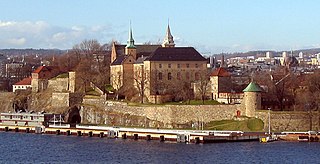
Akershus Fortress or Akershus Castle is a medieval castle in the Norwegian capital Oslo that was built to protect and provide a royal residence for the city. Since the Middle Ages the fortress has been the namesake and centre of the main fief and later main county of Akershus, which was originally one of Norway's four main regions and which included most of Eastern Norway. The fortress itself was located within the Akershus main county until 1919, and also within the smaller Akershus sub county until 1842.

The Royal Palace in Oslo was built in the first half of the 19th century as the Norwegian residence of the French-born King Charles III John, who reigned as king of Norway and Sweden. The palace is the official residence of the current Norwegian monarch while the Crown Prince resides at Skaugum in Asker west of Oslo.

Royal Lodge is a Grade II listed house in Windsor Great Park in Berkshire, England, half a mile north of Cumberland Lodge and 3.2 miles (5.1 km) south of Windsor Castle. The site of homes since the 17th century, the present structure dates from the 19th century, and was expanded in the 1930s for the then duke of York, the future king George VI. Its central section is 3 storeys, with wings two storeys and it has about 30 rooms, with 7 bedrooms. The Royal Chapel of All Saints was built on the grounds in the 1820s.

Carlton House Terrace is a street in the St James's district of the City of Westminster in London. Its principal architectural feature is a pair of terraces, the Western and Eastern terraces, of white stucco-faced houses on the south side of the street, which overlook The Mall and St. James's Park. These terraces were built on Crown land between 1827 and 1832 to overall designs by John Nash, but with detailed input by other architects including Decimus Burton. Construction was overseen by James Pennethorne. Both terrace blocks are Grade I listed buildings. A separate but linked cul de sac at the terrrace's western end is named Carlton Gardens.
Sunninghill Park was a country house and estate of about 665 acres directly north of Cheapside, in the civil parishes of Sunninghill and Ascot and Winkfield, adjoining Windsor Great Park in the English county of Berkshire.
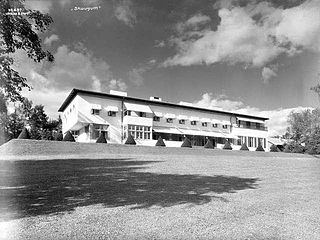
Skaugum is an estate, manor house and the official residence of Crown Prince Haakon of Norway and his wife Crown Princess Mette-Marit. The estate is located in Asker, 19 km (12 mi) southwest of Oslo, by the foot of the mountain Skaugumsåsen. The estate consists of 48 ha of agricultural lands and 50 ha of woodlands.

Stiftsgården is the royal residence in Trondheim, Norway. It is centrally situated on the city’s most important thoroughfare, Munkegaten. At 140 rooms constituting 4000 m² (43000 ft²), it is one of the largest wooden buildings in Northern Europe, and it has been used by royalty and their guests since 1800.

Winkfield is a village and civil parish in the Bracknell Forest unitary authority of Berkshire, England.

Shaw House is an important example of an early symmetrical H-plan Elizabethan mansion, located at Shaw, on the north-eastern outskirts of Newbury in Berkshire.
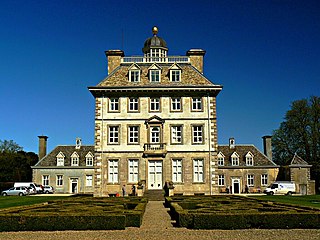
Ashdown House is a 17th-century country house in the civil parish of Ashbury in the English county of Oxfordshire. Until 1974 the house was in the county of Berkshire, and the nearby village of Lambourn remains in that county.

Bygdøy Royal Estate, also known as the Bygdø Royal Farm, is a Kongsgård estate and manor house that occupies a large part of the northwestern part of the Bygdøy peninsula in Oslo, Norway. It is the official summer residence of the King of Norway.

Beckett Hall is a country house at Shrivenham in the English county of Oxfordshire. The present house dates from 1831.
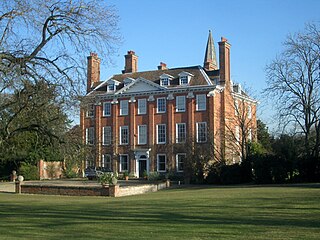
Welford Park is a country house and estate in the village of Welford in the English county of Berkshire, situated 5.2 miles northwest of Newbury and 10.9 miles south of Wantage. It is a Grade I-listed building.
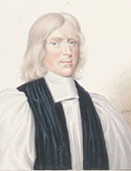
William Lloyd was an English divine who served successively as bishop of St Asaph, of Lichfield and Coventry and of Worcester.

Swallowfield Park is a Grade II* listed stately home and estate in the English county of Berkshire. The house is near the village of Swallowfield, some 4 miles south of the town of Reading.
Sir William Norreys was a famous Lancastrian soldier, and later an Esquire of the Body to King Edward IV.

Terregles House was a late 18th-century country house, located near Terregles, in the historical county of Kirkcudbrightshire around 2 miles west of Dumfries in Scotland. It replaced an earlier tower house, which had served as the seat of the Lords Herries, and later the Earls of Nithsdale, until William Maxwell, the 5th Earl, forfeited his titles in 1716.
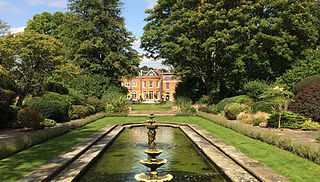
The Royal Berkshire Hotel is a country house hotel within a noteworthy example of a late Queen Anne mansion previously called The Oaks and located at Ascot in the English county of Berkshire.

Coleshill House was a country house in England, near the village of Coleshill, in the Vale of White Horse. Historically, the house was in Berkshire but since boundary changes in 1974 its site is in Oxfordshire.



















